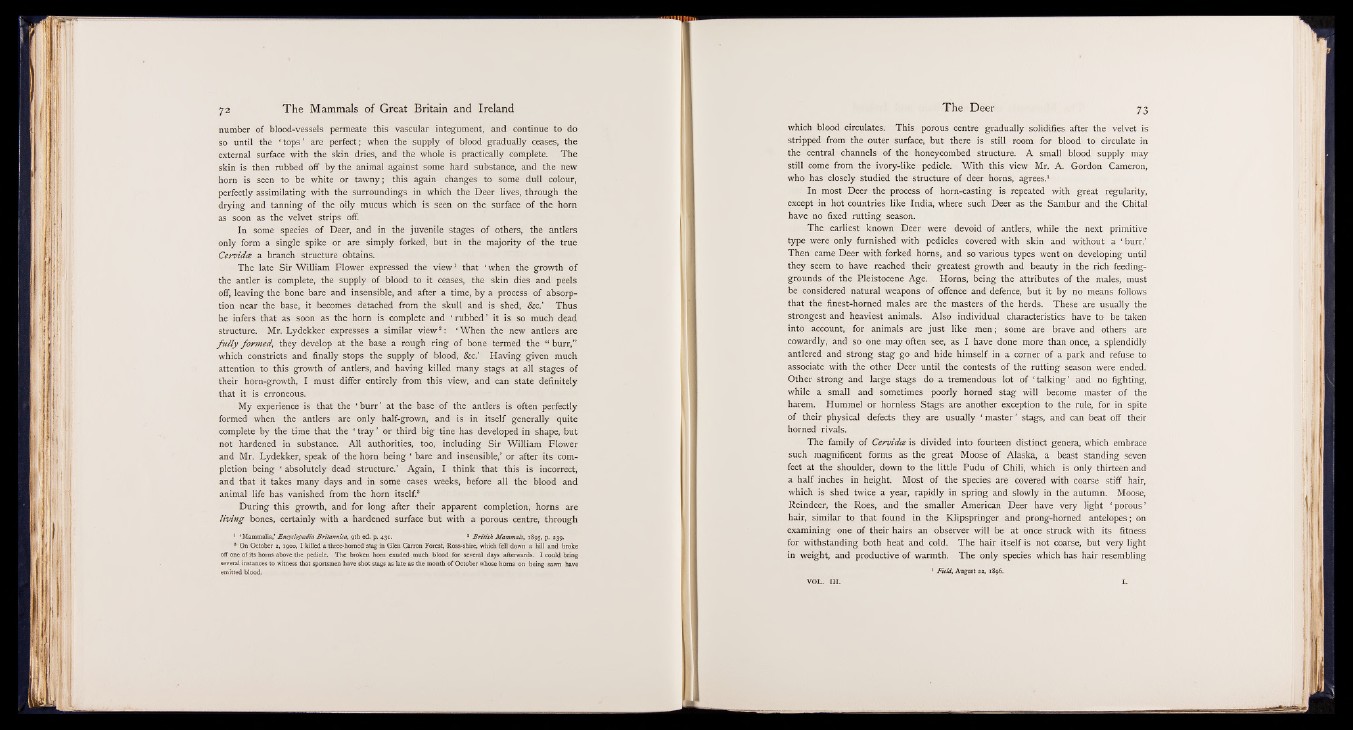
number of blood-vessels permeate this vascular integument, and continue to do
so until the ‘ tops ’ are perfect; when the supply of blood gradually ceases, the
external surface with the skin dries, and the whole is practically complete. The
skin is then rubbed off by the animal against some hard substance, and the new
horn is seen to be white or tawny; this again changes to some dull colour,
perfectly assimilating with the surroundings in which the Deer lives, through the
drying and tanning of the oily mucus which is seen on the surface of the horn
as soon as the velvet strips off.
In some species of Deer, and in the juvenile stages of others, the antlers
only form a single spike or are simply forked, but in the majority of the true
Cervidce a branch structure obtains.
The late Sir William Flower expressed the view1 that ‘ when the growth of
the antler is complete, the supply of blood to it ceases, the skin dies and peels
off, leaving the bone bare and insensible, and after a time, by a process of absorption
near the base, it becomes detached from the skull and is shed, &c.’ Thus
he infers that as soon as the horn is complete and ‘ rubbed ’ it is so much dead
structure. Mr. Lydekker expresses a similar view2: ‘ When the new antlers are
fu lly formed, they develop at the base a rough ring of bone termed the “ burr,”
which constricts and finally stops the supply of blood, &c.’ Having given much
attention to this growth of antlers, and having killed many stags at all stages of
their horn-growth, I must differ entirely from this view, and can state definitely
that it is erroneous.
My experience is that the ‘ burr’ at the base of the antlers is often perfectly
formed when the antlers are only half-grown, and is in itself generally quite
complete by the time that the ‘ tray ’ or third big tine has developed in shape, but
not hardened in substance. All authorities, too, including Sir William Flower
and Mr. Lydekker, speak of the horn being ‘ bare and insensible,’ or after its completion
being ' absolutely dead structure.’ Again, I think that this is incorrect,
and that it takes many days and in some cases weeks, before all the blood and
animal life has vanished from the horn itself.8
During this growth, and for long after their apparent completion, horns are
living bones, certainly with a hardened surface but with a porous centre, through
1 ‘Mammalia,’ Encyclopedia Britannica, 9th ed. p. 431. * B ritish Mammals, 1895, p. 239.
3 On October 2, 1900, I killed a three-horned stag in Glen Carron Forest, Ross-shire, which fell down a hill and broke
off one o f its horns above the pedicle. The broken hom exuded much blood for several days afterwards. I could bring
several instances to witness that sportsmen have shot stags as late as the month of October whose horns on being sawn have
emitted blood.
which blood circulates. This porous centre gradually solidifies after the velvet is
stripped from the outer surface, but there is still room for blood to circulate in
the central channels of the honeycombed structure. A small blood supply may
still come from the ivory-like pedicle. With this view Mr. A. Gordon Cameron,
who has closely studied the structure of deer horns, agrees.1
In most Deer the process of horn-casting is repeated with great regularity,
except in hot countries like India, where such Deer as the Sambur and the Chital
have no fixed rutting season.
The earliest known Deer were devoid of antlers, while the next primitive
type were only furnished with pedicles covered with skin and without a ‘ burr.’
Then came Deer with forked horns, and so various types went on developing until
they seem to have reached their greatest growth and beauty in the rich feeding-
grounds of the Pleistocene Age. Horns, being the attributes of the males, must
be considered natural weapons of offence and defence, but it by no means follows
that the finest-horned males are the masters of the herds. These are usually the
strongest and heaviest animals. Also individual characteristics have to be taken
into account, for animals are just like men; some are brave and others are
cowardly, and so one may often see, as I have done more than once, a splendidly
antlered and strong stag go and hide himself in a corner of a park and refuse to
associate with the other Deer until the contests of the rutting season were ended.
Other strong and large stags do a tremendous lot of ‘ talking’ and no fighting,
while a small and sometimes poorly horned stag will become master of the
harem. Hummel or hornless Stags are another exception to the rule, for in spite
of their physical defects they are usually ‘ master ’ stags, and can beat off their
horned rivals.
The family of Cervidce is divided into fourteen distinct genera, which embrace
such magnificent forms as the great Moose of Alaska, a beast standing seven
feet at the shoulder, down to the little Pudu of Chili, which is only thirteen and
a half inches in height. Most of the species are covered with coarse stiff hair,
which is shed twice a year, rapidly in spring and slowly in the autumn. Moose,
Reindeer, the Roes, and the smaller American Deer have very light ‘ porous ’
hair, similar to that found in the Klipspringer and prong-horned antelopes; on
examining one of their hairs an observer will be at once struck with its fitness
for withstanding both heat and cold. The hair itself is not coarse, but very light
in weight, and productive of warmth. The only species which has hair resembling
VOL. III.
1 Field, August 22, 1896.